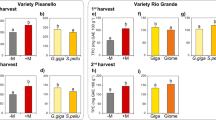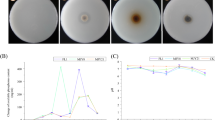Abstract
Non-mycorrhizal fungal root endophytes can be found in all natural and cultivated ecosystems, but little is known about their impact on plant performance. The impact of three mitosporic dark septate endophytes (DSE48, DSE49 and Leptodontidium orchidicola) on tomato plant characteristics was studied. Their effects on root and shoot growth, their influence on fruit yield and fruit quality parameters and their ability to diminish the impact of the pathogen Verticillium dahliae were investigated. While shoot biomass of young plants was enhanced between 10% and 20% by the endophytes DSE48 and L. orchidicola in one of two experiments and by DSE49 in both experiments, vegetative growth parameters of 24-week-old plants were not affected except a reproducible increase of root diameter by the isolate DSE49. Concerning fruit yield and quality, L. orchidicola could double the biomass of tomatoes and increased glucose content by 17%, but this was dependent on date of harvest and on root colonisation density. Additionally, the endophytes DSE49 and L. orchidicola decreased the negative effect of V. dahliae on tomato, but only at a low dosage of the pathogen. This indicates that the three dark septate endophytes can have a significant impact on tomato characters, but that the effects are only obvious at early stages of vegetative and generative development and currently too inconsistent to recommend the application of these DSEs in horticultural practice.

Similar content being viewed by others
References
Achatz B, von Rüden S, Andrade D, Neumann E, Pons-Kühnemann J, Kogel K-H, Franken P, Waller F (2010) Root colonization by Piriformospora indica enhances grain yield in barley under diverse nutrient regimes by accelerating plant development. Plant Soil 333:59–70
Alabouvette C, Olivain C, Migheli Q, Steinberg C (2009) Microbiological control of soil-borne phytopathogenic fungi with special emphasis on wilt-inducing Fusarium oxysporum. New Phytol 184:529–544
Alberton O, Kuyper TW, Summerbell RC (2010) Dark septate root endophytic fungi increase growth of Scots pine seedlings under elevated CO2 through enhanced nitrogen use efficiency. Plant Soil 328:459–470
Andrade-Linares DR, Grosch R, Franken P (2011) Screening of tomato endophytic fungi for potential biological agents. IOBC/WPRS Bulletin
Anonymous (1992) Kleur-stadia tomaten. Central Bureau van de Tuibouwveilingen in Nederland, Gouda, The Netherlands
Barazani O, Von Dahl CC, Baldwin IT (2007) Sebacina vermifera promotes the growth and fitness of Nicotiana attenuata by inhibiting ethylene signaling. Plant Physiol 144:1223–1232
Bütehorn B, Rhody D, Franken P (2000) Isolation and characterisation of Pitef1 encoding the translation elongation factor EF-1alpha of the root endophyte Piriformospora indica. Plant Biol 2:687–692
Conn VM, Franco CMM (2004) Effect of microbial inoculants on the indigenous actinobacterial endophyte population in the roots of wheat as determined by terminal restriction fragment length polymorphism. Appl Environ Microbiol 70:6407–6413
Conrath U, Beckers GJM, Flors V, Garcia-Agustin P, Jakab G, Mauch F, Newman MA, Pieterse CMJ, Poinssot B, Pozo MJ, Pugin A, Schaffrath U, Ton J, Wendehenne D, Zimmerli L, Mauch-Mani B (2006) Priming: getting ready for battle. Mol Plant-Microb Interact 19:1062–1071
Daie J, Campbell WF (1981) Response of tomato plants to stressful temperatures. Plant Physiol 67:26–29
De Kreij C, Voogt W, van den Bos AL, Baas R (1997) Voedingsoplossingen voor de teelt van tomaat in gesloten teeltsystemen. Brochure VG Tomaat, The Netherlands
Deshmukh S, Hueckelhoven R, Schaefer P, Imani J, Sharma M, Weiss M, Waller F, Kogel KH (2006) The root endophytic fungus Piriformospora indica requires host cell death for proliferation during mutualistic symbiosis with barley. Proc Natl Acad Sci USA 103:18450–18457
Fakhro A, Andrade-Linares DR, von Bargen S, Bandte M, Buttner C, Grosch R, Schwarz D, Franken P (2010) Impact of Piriformospora indica on tomato growth and on interaction with fungal and viral pathogens. Mycorrhiza 20:191–200
Fernando AA, Currah RS (1996) A comparative study of the effects of the root endophytes Leptodontidium orchidicola and Phialocephala fortinii (Fungi Imperfecti) on the growth of some subalpine plants in culture. Can J Bot 74:1071–1078
Fradin EF, Thomma BPHJ (2006) Physiology and molecular aspects of Verticillium wilt diseases caused by V. dahliae and V. albo-atrum. Mol Plant Physiol 7:71–86
Guil-Guerrero JL, Rebolloso-Fuentes MM (2009) Nutrient composition and antioxidant activity of eight tomato (Lycopersicon esculentum) varieties. J Food Compos Anal 22:123–129
Gutjahr C, Paszkowski U (2009) Weights in the balance: jasmonic acid and salicylic acid signaling in root-biotroph interactions. Mol Plant-Microb Interact 22:763–772
Harman GE, Howell CR, Viterbo A, Chet I, Lorito M (2004) Trichoderma species—opportunistic, avirulent plant symbionts. Nat Rev Microbiol 2:43–56
Hoitink HAJ, Boehm MJ (1999) Biocontrol within the context of soil microbial communities: a substrate-dependent phenomenon. Annu Rev Phytopathol 37:427–446
Johnson C, Hall JL, Ho LC (1988) Pathways of uptake and accumulation of sugars in tomato fruit. Ann Bot 61:593–603
Jumpponen A (2001) Dark septate endophytes—are they mycorrhizal? Mycorrhiza 11:207–211
Jumpponen A, Trappe JM (1998) Performance of Pinus contorta inoculated with two strains of root endophytic fungus, Phialocephala fortinii: effects of synthesis system and glucose concentration. Can J Bot 76:1205–1213
Jumpponen A, Mattson KG, Trappe JM (1998) Mycorrhizal functioning of Phialocephala fortinii with Pinus contorta on glacier forefront soil: interactions with soil nitrogen and organic matter. Mycorrhiza 7:261–265
Kogel KH, Franken P, Hückelhoven R (2006) Endophyte or parasite—what decides? Curr Opin Plant Biol 9:358–363
Krumbein A, Peters P, Brückner B (2004) Flavour compounds and a quantitative descriptive analysis of tomatoes (Lycopersicon esculentum Mill.) of different cultivars in short-term storage. Postharvest Biol Technol 32:15–28
Krumbein A, Schwarz D, Kläring HP (2006) Effects of environmental factors on carotenoid content in tomato (Lycopersicon esculentum Mill.) grown in a greenhouse. J Appl Bot Food Qual 80:160–164
Mandyam K, Jumpponen A (2005) Seeking the elusive function of the root-colonising dark septate endophytic fungi. Stud Mycol 56(1):173–189
Morgan DP, Epstein L, Ferguson L (1992) Verticillium wilt resistance in pistachio rootstock cultivars—assays and an assessment of 2 interspecific hybrids. Plant Dis 76:310–313
Murashige T, Skoog F (1962) A revised medium for rapid growth and bio-assays with tobacco tissue cultures. Physiol Plant 15:473–479
Narisawa K, Kawamata H, Currah RS, Hashiba T (2002) Suppression of Verticillium wilt in eggplant by some fungal root endophytes. Eur J Plant Pathol 108:103–109
Narisawa K, Usuki F, Hashiba T (2004) Control of Verticillium yellows in chinese cabbage by the dark septate endophytic fungus LtVB3. Phytopathology 94:412–418
Ojiambo PS, Scherm H (2006) Biological and application-oriented factors influencing plant disease suppression by biological control: a meta-analytical review. Phytopathology 96:1168–1174
Parlevliet JE (2002) Durability of resistance against fungal, bacterial and viral pathogens; present situation. Euphytica 124:147–156
Pegg G, Brady B (2002) Verticillium wilts. Cabi Publishing, Oxford
Pontecorvo G, Roper JA, Hemmons LM, Macdonald KD, Bufton AWJ (1953) The genetics of Aspergillus nidulans. Adv Genet 5:141–238
Redman RS, Dunigan DD, Rodriguez RJ (2001) Fungal symbiosis from mutualism to parasitism: who controls the outcome, host or invader? New Phytol 151:705–716
Rodriguez R, White J, Arnold A, Redman R (2009) Fungal endophytes: diversity and functional roles. New Phytol 182:314–330
Roitsch T, Balibrea ME, Hofmann M, Proels R, Sinha AK (2003) Extracellular invertase: key metabolic enzyme and PR protein. J Exp Bot 54:513–524
Schäfer P, Pfiffi S, Voll LM, Zajic D, Chandler PM, Waller F, Scholz U, Pons-Kuhnemann J, Sonnewald S, Sonnewald U, Kogel KH (2009) Manipulation of plant innate immunity and gibberellin as factor of compatibility in the mutualistic association of barley roots with Piriformospora indica. Plant J 59:461–474
Schulz B, Boyle C (2005) The endophytic continuum. Mycol Res 109:661–686
Shahollari B, Vadassery J, Varma A, Oelmuller R (2007) A leucine-rich repeat protein is required for growth promotion and enhanced seed production mediated by the endophytic fungus Piriformospora indica in Arabidopsis thaliana. Plant J 50:1–13
Shivanna MB, Meera MS, Hyakumachi M (1994) Sterile fungi from Zoysiagrass rhizosphere as plant-growth promoters in spring wheat. Can J Microbiol 40:637–644
Shoresh M, Harman GE, Mastouri F (2010) Induced systemic resistance and plant responses to fungal biocontrol agents. Annu Rev Phytopathol 48:1–23
Sinha AK, Wood RKS (1968) Resistance to vascular wilt parasites. Neth J Plant Pathol 74:149–156
Sirrenberg A, Goebel C, Grond S, Czempinski N, Ratzinger A, Karlovsky P, Santos P, Feussner I, Pawlowski K (2007) Piriformospora indica affects plant growth by auxin production. Physiol Plant 131:581–589
Soares WL, Porto MFD (2009) Estimating the social cost of pesticide use: an assessment from acute poisoning in Brazil. Ecol Econ 68:2721–2728
Stammler G, Strobel D, Semar M, Klappach K (2006) Diagnostics of fungicide resistance and relevance of laboratory data for the field. Asp Appl Biol 78:29–36
Trouvelot A, Kough JL, Gianinazzi-Pearson V (1986) Mesure du taux de mycorhization VA d’un système radiculaire. Recherche des méthodes d'estimation ayant une signification fonctionnelle. In: Gianinazzi-Pearson V, Gianinazzi S (eds) The mycorrhizae: physiology and genetic. INRA Presse, Paris, pp 217–221
Upson R, Read DJ, Newsham KK (2009) Nitrogen form influences the response of Deschampsia antarctica to dark septate root endophytes. Mycorrhiza 20:1–11
Vadassery J, Ritter C, Venus Y, Camehl I, Varma A, Shahollari B, Novak O, Strnad M, Ludwig-Muller J, Oelmuller R (2008) The role of auxins and cytokinins in the mutualistic interaction between Arabidopsis and Piriformospora indica. Mol Plant-Microb Interact 21:1371–1383
Varma A, Verma S, Sudha SN, Butehorn B, Franken P (1999) Piriformospora indica, a cultivable plant-growth-promoting root endophyte. Appl Environ Microbiol 65:2741–2744
Venema JH, Posthumus F, van Hasselt PR (1999) Impact of suboptimal temperature on growth, photosynthesis, leaf pigments and carbohydrates of domestic and high-altitude wild Lycopersicon species. J Plant Physiol 155:711–718
Veronese P, Narasimhan ML, Stevenson RA, Zhu JK, Weller SC, Subbarao KV, Bressan RA (2003) Identification of a locus controlling Verticillium disease symptom response in Arabidopsis thaliana. Plant J 35:574–587
Vinale F, Sivasithamparam K, Ghisalberti EL, Marra R, Barbetti MJ, Li H, Woo SL, Lorito M (2008) A novel role for Trichoderma secondary metabolites in the interactions with plants. Physiol Mol Plant Pathol 72:80–86
Weiss M, Selosse MA, Rexer KH, Urban A, Oberwinkler F (2004) Sebacinales: a hitherto overlooked cosm of heterobasidiomycetes with a broad mycorrhizal potential. Mycol Res 108:1003–1010
Whipps JM (2001) Microbial interactions and biocontrol in the rhizosphere. J Exp Bot 52:487–511
Wilson D (1995) Endophyte—the evolution of a term, and clarification of its use and definition. Oikos 73:274–276
Wu LQ, Guo SX (2008) Interaction between an isolate of dark-septate fungi and its host plant Saussurea involucrata. Mycorrhiza 18:79–85
Wu LQ, Lv YL, Meng ZX, Chen J, Guo SX (2010) The promoting role of an isolate of dark-septate fungus on its host plant Saussurea involucrata Kar. et Kir. Mycorrhiza 20:127–135
Zhao YC, Hasenstein KH (2009) Primary root growth regulation: the role of auxin and ethylene antagonists. J Plant Growth Regul 28:309–320
Acknowledgements
This research was supported by the Ministries of Consumer Protection, Food and Agriculture of the Federal Republic of Germany, of the Land Brandenburg and of the Land Thüringen. DR Andrade-Linares was supported by the German Academic Exchange Service (DAAD). We are grateful for technical assistance to Mrs. Fandrey and Mrs. Widiger (pathosystem and climate chambers experiments), Mrs. Rathenow, Mrs. Hasse, Mrs. Stefanowski, Mrs. Marten (cultivation and harvest of plants) and Mrs. Jankowsky and Mrs. Platalla (quality analysis). The V. dahliae strain was kindly provided by Valerie Grimault (GEVES, Angers, France).
Author information
Authors and Affiliations
Corresponding author
Rights and permissions
About this article
Cite this article
Andrade-Linares, D.R., Grosch, R., Restrepo, S. et al. Effects of dark septate endophytes on tomato plant performance. Mycorrhiza 21, 413–422 (2011). https://doi.org/10.1007/s00572-010-0351-1
Received:
Accepted:
Published:
Issue Date:
DOI: https://doi.org/10.1007/s00572-010-0351-1




